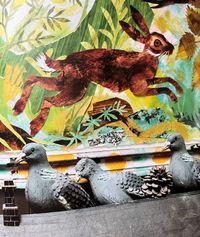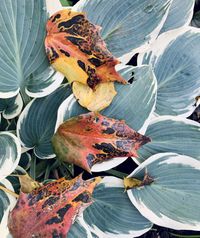"The air is full of tunes. A piece of rock is full of statues. The earth is full of visions. The world is full of stories. As an artist, you trust that. You trust that that is so."
"I am a product of attics explored..." C. S. Lewis proudly admitted of his childhood, whereas David Attenborough remembered in childhood, he spent days lifting rocks to find bugs. The neurons in my cerebellum are pulsing in recognition. Do you have such a place? One that cradled stoked and now houses your imagination?
My grandparents' forested acreage; our quiet, cool basement; and even the plastic flower section of the garden center while my mom sought seasonal plants, I was lost in worlds of my creation. But the space and shape of childhood are only one imprint on imagination. There are many, many more.
Let's summon the marvelous Ursula Le Guin (October 21, 1929 - January 22, 2018), a master of world creation, species invention, and language expansion.
Le Guin has this to say on creativity:
The question fiction writers get most often is: Where do you get your ideas from? Harlan Ellison has been saying for years that he gets ideas for his stories from a mail-order house in Schenectady. When people ask "Where do you get your ideas from?" what some of them want to know is the e-mail address of that company in Schenectady. That is: they want to be writers because they know writers are rich and famous; and they know that there are secrets that writers know; and they know if they can just learn those secrets, that mystical address in Schenectady, they will be Stephen King.”
Le Guin succinctly emphasizes the distinction between wanting to know about your creative process and about "a creative process" so you can copy it.
 "Ursula K. Le Guin" by Natasha Rauf for The Examined Life.
"Ursula K. Le Guin" by Natasha Rauf for The Examined Life.And yet, as Le Guin notes, the question of 'where do ideas come from' is valid for all creatives. Once the shallow inquiry is kicked aside, what remains is this: how do I tap into what I know is there but is either invisible or silent - or both?
"How does the artist find that, see it, before it's visible?" Le Guin asks knowingly.
So why did I want to try to answer this foolish question, Where do you get your ideas from? Because underneath the foolishness is a real question, which people yearn to have answered — a big question. Art is craft: all art is always and essentially a work of craft: but in the true work of art, before the craft and after it, is some essential, durable core of being, which is what the craft works on, and shows, and sets free. The statue in the stone. How does the artist find that, see it, before it's visible? That is a real question.”
"Everyone has a bird story," promises nature poet, teacher, and avid birder, J. Drew Langham, who guides our hearts into nature and puts what we feel on the page. Langham echoes something sculptor Barbara Hepworth observed in an abstract sense: "Everything physical thing has a presence." The substance of thingness - importance, value, and personal meaning - surrounds us. Alive or not, things are jumping, clawing, bleating, and beckoning we notice.
 "Bolting Away" collage by Mark Hearld, who finds joy in the raucous that is the creative process. Photograph by Hermione McCosh.
"Bolting Away" collage by Mark Hearld, who finds joy in the raucous that is the creative process. Photograph by Hermione McCosh.There are multiple - far too many - guides on how to materialize a story out of nothing. That is not what Le Guin tackles. Instead, her essay, The Wave in the Mind, focuses on how we find something we care about so profoundly, in such rich detail - that we want to use it as a cornerstone of meaningful art.
Le Guin continues:
Fiction results from imagination working on experience. We shape experience in our minds so that it makes sense. We force the world to be coherent-to tell us a story. Not only fiction writers do this; we all do it; we do it constantly, continually, to survive. People who can't make the world into a story go mad. Or, like infants or (perhaps) animals, they live in a world that has no history, no time but now.”
Poet Mary Ruefle called imagination the "invisible everything" in her short meditation on the subject. This rich flow of thought, letter, and substance twists from which we pull and into which we step. It might take the shape of attics, but we carry them with us our entire lives.
Le Guin's body of work is undeniably imaginative - the science fiction genre (please note Le Guin understandably disliked being known only as a science fiction writer) demands of its creator attention to all aspects of the world, from flora and fauna to the communication systems to the color of the sky (or existence of sky.) So is our experience still valid? How do we hammer experience into more than it is if we do not hold to what it is?
That is, explains Le Guin, where invention comes in.
Experience is where the ideas come from. But a story isn't a mirror of what happened. Fiction is experience translated by, transformed by, and transfigured by the imagination. Truth includes but is not coextensive with fact. Truth in art is not imitation, but reincarnation. In a factual history or memoir, the raw material of experience, to be valuable, has to be selected, arranged, and shaped. In a novel, the process is even more radical: the raw materials are not only selected and shaped but fused, composted, recombined, reworked, reconfigured, reborn, and at the same time allowed to find their forms and shapes, which may be only indirectly related to rational thinking. The whole thing may end up looking like pure invention. A girl chained to a rock as a sacrifice to a monster. A mad captain and a white whale. A ring that confers absolute power. A dragon. But there's no such thing as pure invention. It all starts with experience.”
 "Blue Form in a Scene" by Helen Frankenthaler, 1961. "The raw material of experience are not only selected and shaped but fused, composted, recombined, reworked, reconfigured, reborn, and simultaneously allowed to find their own forms and shapes," Le Guin notes. Whitney Museum of American Art, New York.
"Blue Form in a Scene" by Helen Frankenthaler, 1961. "The raw material of experience are not only selected and shaped but fused, composted, recombined, reworked, reconfigured, reborn, and simultaneously allowed to find their own forms and shapes," Le Guin notes. Whitney Museum of American Art, New York.The strength of the artist is vast and encompassing. It must include the ability to sit all day doing nothing except obsessing about sitting all day doing nothing and still believe that one will be an artist tomorrow. The world often measures artistic talent on potential: the next project, the next painting, and the next film. At times an artist is propelled by nothing but will and memory.
"The world is full of stories," Le Guin promises, "As an artist, you trust that. You trust that that is so." Do we? I know I am an artist (blogger, critic, whatever) today. I am only very loosely assured that my tomorrow self will rise to that challenge.
For many, the most challenging aspect of being an artist is trusting that the slippery, shiny rocks somehow collected on the morning walk will gather together into a feeling of beauty and that sentiment will sum into an original thought, and that imagination will morph, through invention and talent, into something sublimely beautiful like Mary Oliver's original, immediately relatable poem about rocks under the soil waiting to be touched by rain.
What if the rocks are just rocks? Collect them anyway, Le Guin would tell us. Collect them anyway, and arrange them into a pattern, a conflict, a communication.
 Mahonia meets hosta and creates a botanical metaphor for my life: part preppy and smooth-edged, part thorny fires of Mordor. It's a memorable nudge.
Mahonia meets hosta and creates a botanical metaphor for my life: part preppy and smooth-edged, part thorny fires of Mordor. It's a memorable nudge."Art is craft." Le Guin reminds us, embracing the concept long before the wonders of craft resuscitated our social media feeds. Within every sourdough starter and crochet snowflake lurks a creative soul wanting to stretch their talents and untethered creative intelligence into something that lasts, is meaningful, and ultimately reflects human nature.
Le Guin's words on craft are worth repeating:
Art is craft: all art is always and essentially a work of craft: but in the true work of art, before the craft and after it, is some essential, durable core of being, which is what the craft works on, and shows, and sets free.
Pick up stones, spend time in attics, crochet through the afternoon, or whatever perks the excitement of making. And if you want to step away from that for a second, sink your eyeballs into Dani Shapiro's wisdom on the discipline required to turn memory and inspiration into the materialized craft of writing; how we turn ordinary objects into things that matter; a look at the specific human need to exhale all that we are to make room for something new, and a collection of artists sharing how they begin how they go.

